Abstract
The degradation of the polynuclear aromatic hydrocarbons (PAHs) anthracene and naphthalene by the microbiota of intertidal sediments was investigated in laboratory studies. No mineralization of either PAH was observed in the absence of oxygen. Both rates and total amounts of PAH mineralization were strongly controlled by oxygen content and temperature of the incubations. Inorganic nitrogen and glucose amendments had minimal effects on PAH mineralization. The rates and total amounts of PAH mineralized were directly related to compound concentration, pre-exposure time, and concentration. Maximum mineralization was observed at the higher concentrations (5 to 100 μg/g [ppm]) of both PAHs. Optimal acclimation to anthracene and naphthalene (through pre-exposures to the compounds) occurred at the highest acclimation concentration (1,000 ppm). However, acclimation to a single concentration (100 ppm) resulted in initial relative mineralization rates over a range of re-exposure concentrations (1 to 1,000 ppm) being nearly identical. Maximum mineralization of both PAHs occurred after intermediate periods (1 to 2 weeks) of pre-exposure. The fraction of the total heterotrophic population capable of utilizing anthracene or naphthalene as sole carbon source was also greatest after 2 weeks.
Full text
PDF

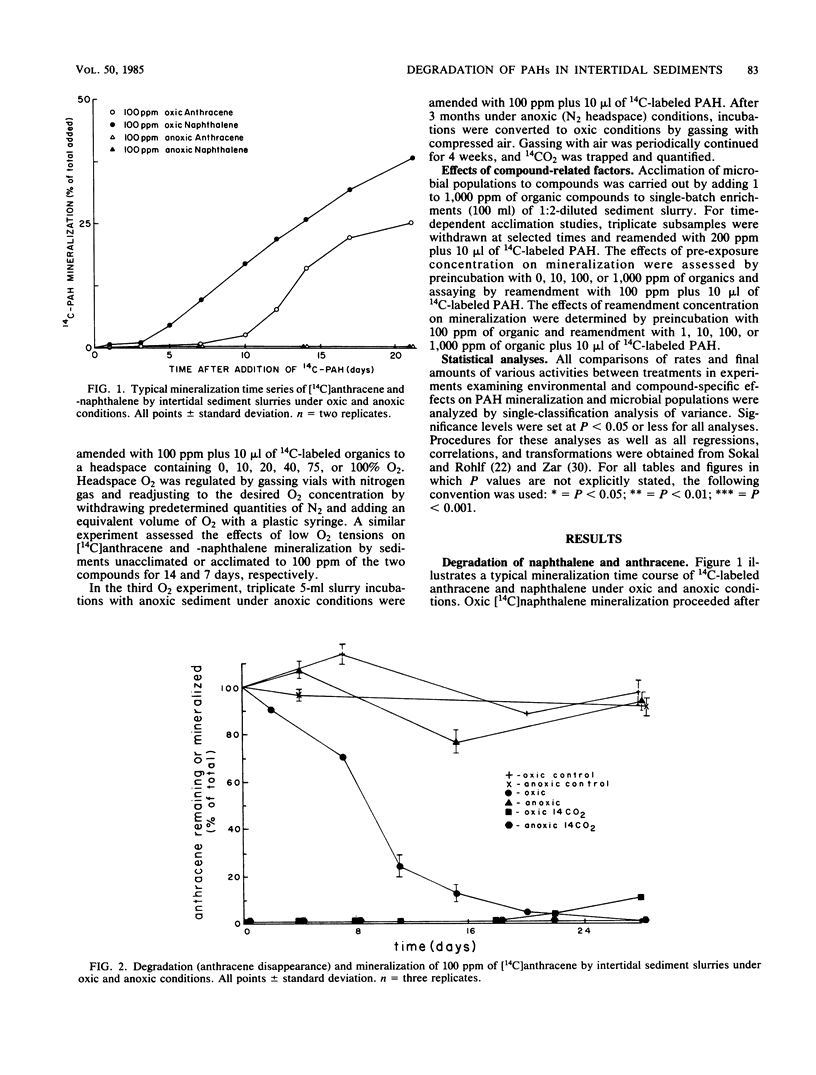
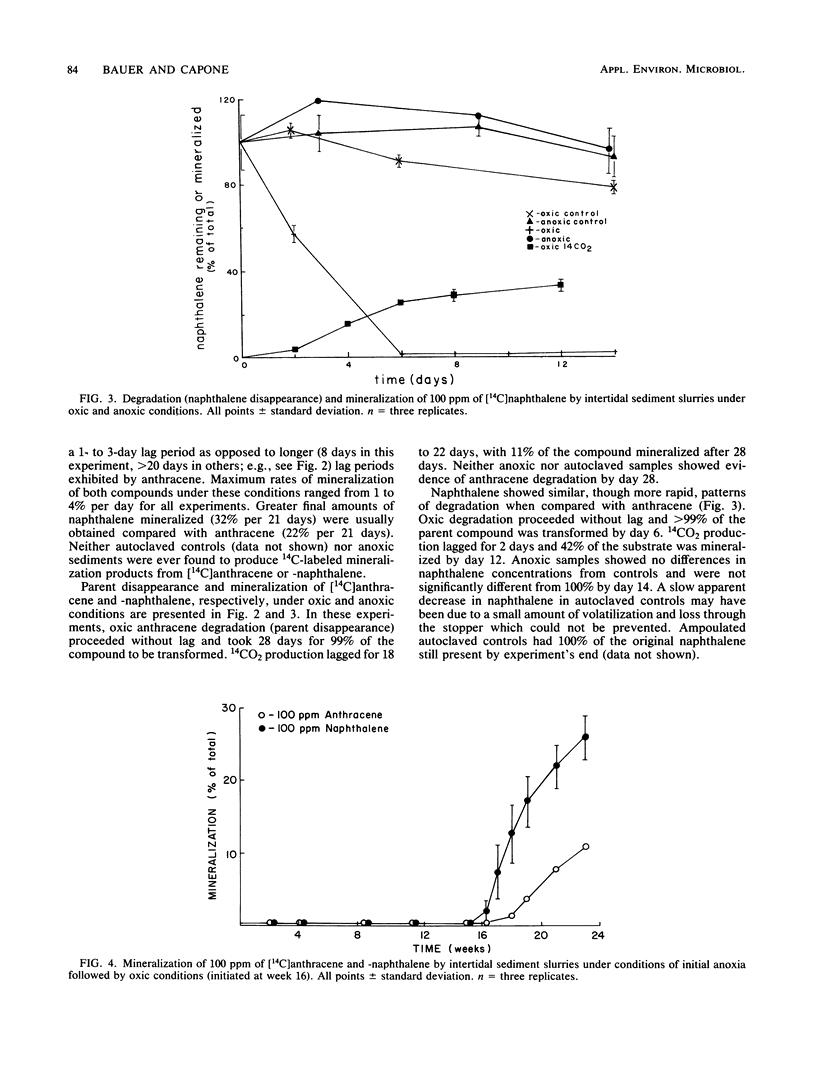
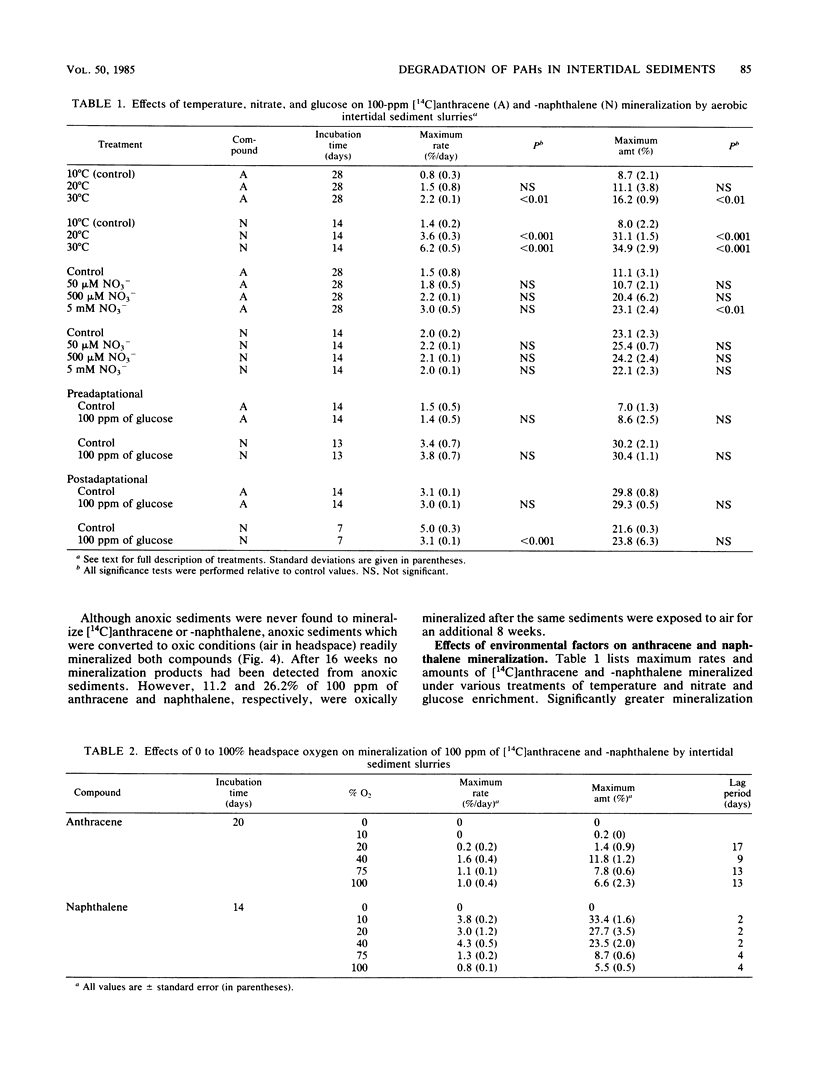
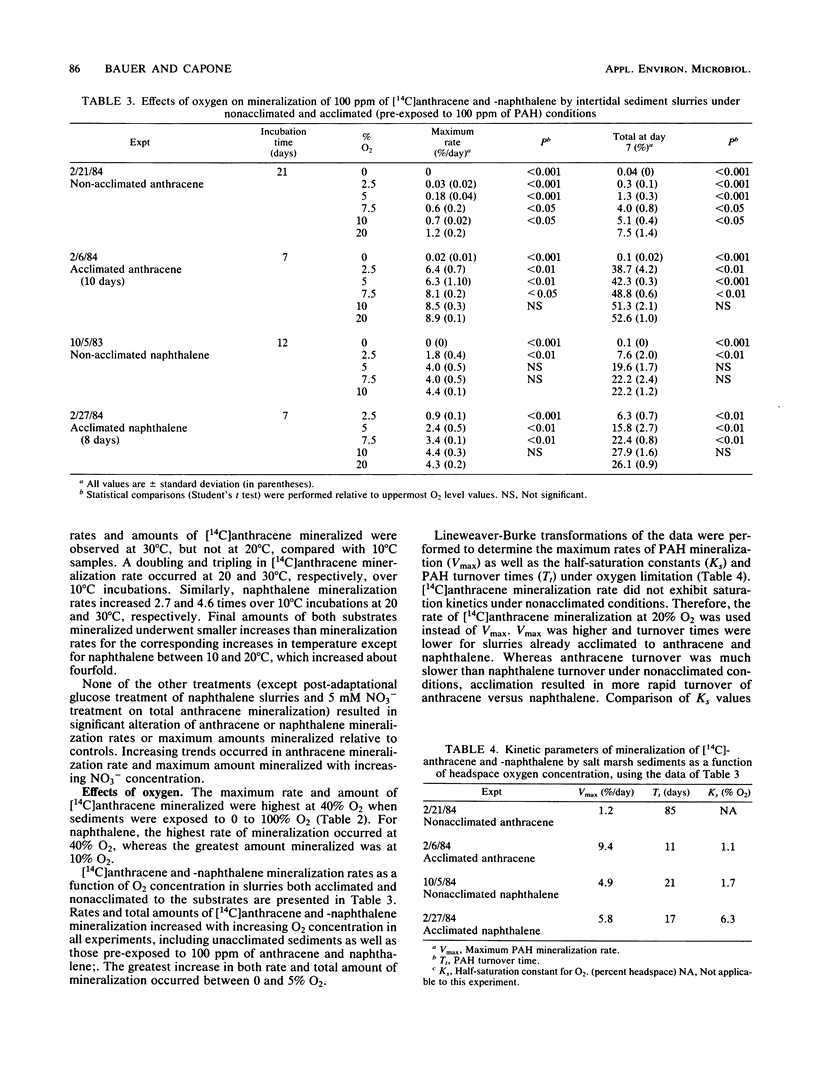
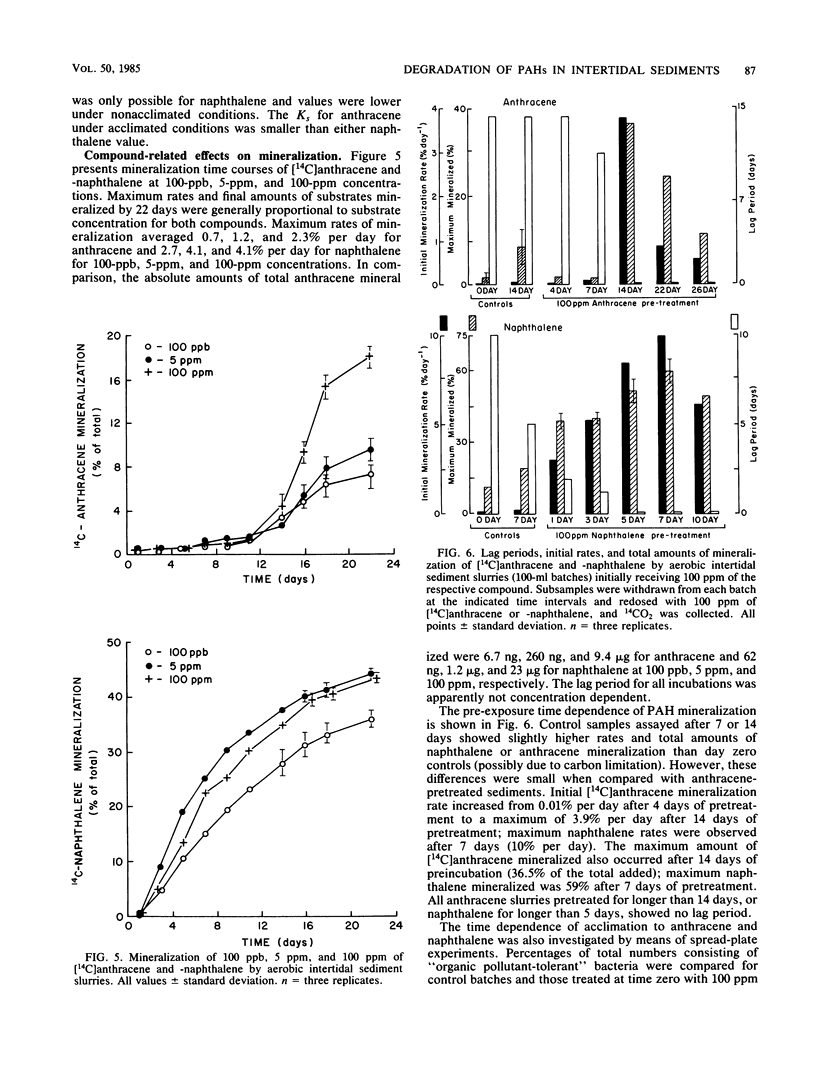
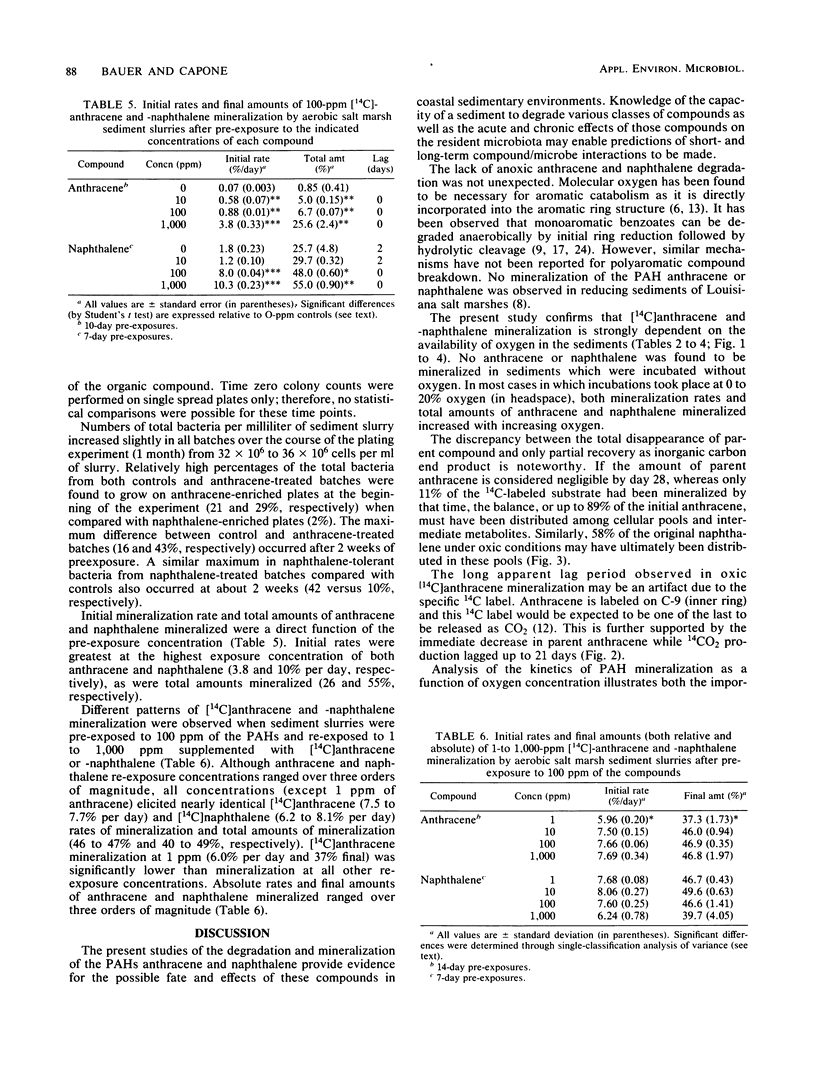
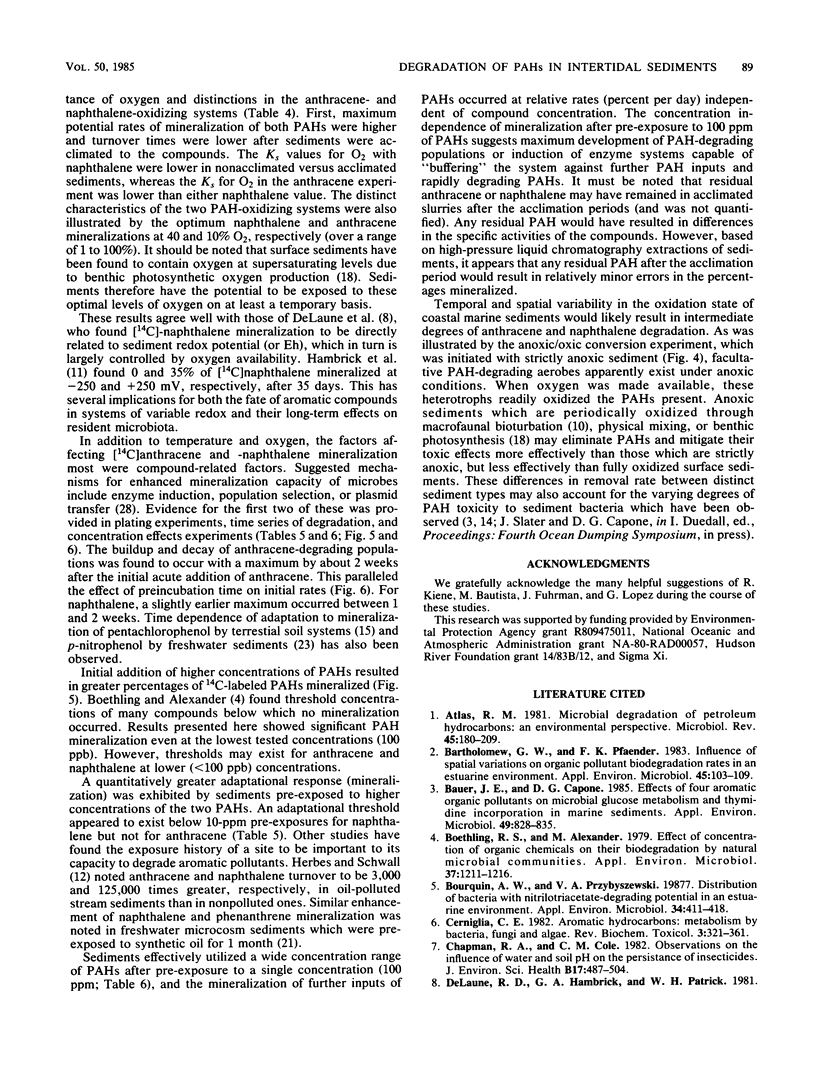
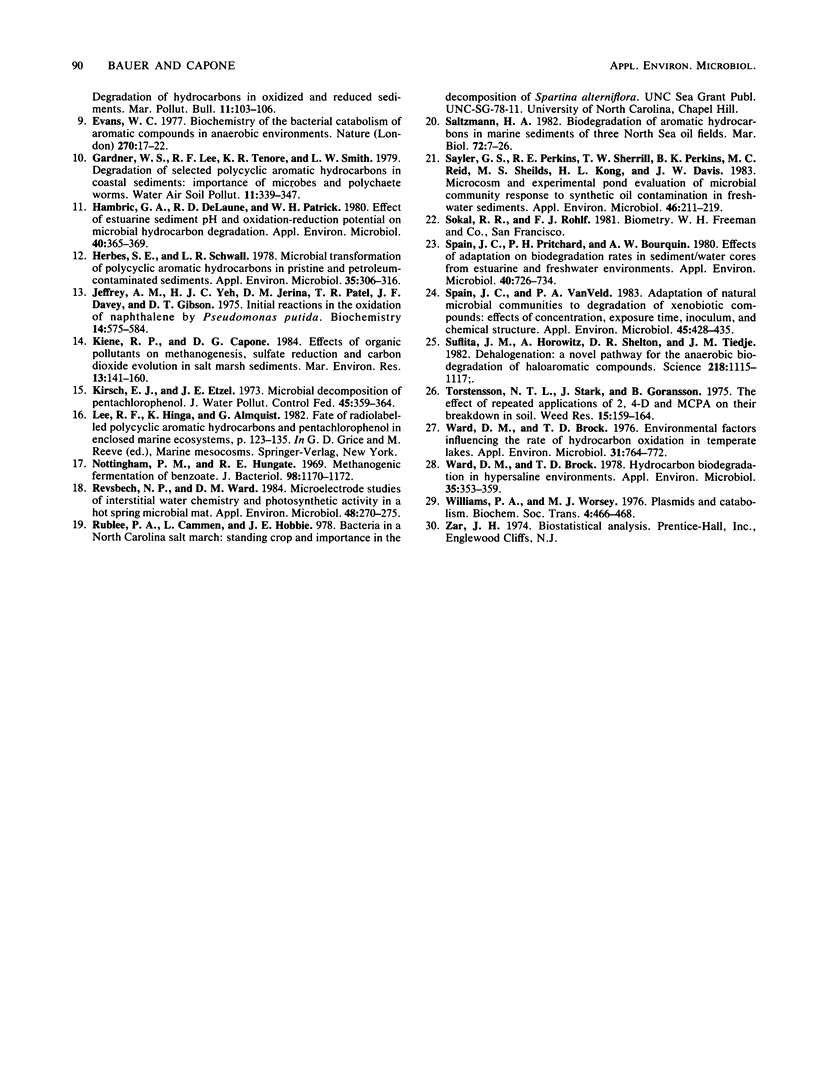
Selected References
These references are in PubMed. This may not be the complete list of references from this article.
- Atlas R. M. Microbial degradation of petroleum hydrocarbons: an environmental perspective. Microbiol Rev. 1981 Mar;45(1):180–209. doi: 10.1128/mr.45.1.180-209.1981. [DOI] [PMC free article] [PubMed] [Google Scholar]
- Bartholomew G. W., Pfaender F. K. Influence of spatial and temporal variations on organic pollutant biodegradation rates in an estuarine environment. Appl Environ Microbiol. 1983 Jan;45(1):103–109. doi: 10.1128/aem.45.1.103-109.1983. [DOI] [PMC free article] [PubMed] [Google Scholar]
- Bauer J. E., Capone D. G. Effects of four aromatic organic pollutants on microbial glucose metabolism and thymidine incorporation in marine sediments. Appl Environ Microbiol. 1985 Apr;49(4):828–835. doi: 10.1128/aem.49.4.828-835.1985. [DOI] [PMC free article] [PubMed] [Google Scholar]
- Boethling R. S., Alexander M. Effect of concentration of organic chemicals on their biodegradation by natural microbial communities. Appl Environ Microbiol. 1979 Jun;37(6):1211–1216. doi: 10.1128/aem.37.6.1211-1216.1979. [DOI] [PMC free article] [PubMed] [Google Scholar]
- Chapman R. A., Cole C. M. Observations on the influence of water and soil pH on the persistence of insecticides. J Environ Sci Health B. 1982;17(5):487–504. doi: 10.1080/03601238209372336. [DOI] [PubMed] [Google Scholar]
- Evans W. C. Biochemistry of the bacterial catabolism of aromatic compounds in anaerobic environments. Nature. 1977 Nov 3;270(5632):17–22. doi: 10.1038/270017a0. [DOI] [PubMed] [Google Scholar]
- Hambrick G. A., Delaune R. D., Patrick W. H. Effect of Estuarine Sediment pH and Oxidation-Reduction Potential on Microbial Hydrocarbon Degradation. Appl Environ Microbiol. 1980 Aug;40(2):365–369. doi: 10.1128/aem.40.2.365-369.1980. [DOI] [PMC free article] [PubMed] [Google Scholar]
- Herbes S. E., Schwall L. R. Microbial transformation of polycyclic aromatic hydrocarbons in pristine and petroleum-contaminated sediments. Appl Environ Microbiol. 1978 Feb;35(2):306–316. doi: 10.1128/aem.35.2.306-316.1978. [DOI] [PMC free article] [PubMed] [Google Scholar]
- Jeffrey A. M., Yeh H. J., Jerina D. M., Patel T. R., Davey J. F., Gibson D. T. Initial reactions in the oxidation of naphthalene by Pseudomonas putida. Biochemistry. 1975 Feb 11;14(3):575–584. doi: 10.1021/bi00674a018. [DOI] [PubMed] [Google Scholar]
- Kirsch E. J., Etzel J. E. Microbial decomposition of pentachlorophenol. J Water Pollut Control Fed. 1973 Feb;45(2):359–364. [PubMed] [Google Scholar]
- Nottingham P. M., Hungate R. E. Methanogenic fermentation of benzoate. J Bacteriol. 1969 Jun;98(3):1170–1172. doi: 10.1128/jb.98.3.1170-1172.1969. [DOI] [PMC free article] [PubMed] [Google Scholar]
- Revsbech N. P., Ward D. M. Microelectrode studies of interstitial water chemistry and photosynthetic activity in a hot spring microbial mat. Appl Environ Microbiol. 1984 Aug;48(2):270–275. doi: 10.1128/aem.48.2.270-275.1984. [DOI] [PMC free article] [PubMed] [Google Scholar]
- Sayler G. S., Perkins R. E., Sherrill T. W., Perkins B. K., Reid M. C., Shields M. S., Kong H. L., Davis J. W. Microcosm and experimental pond evaluation of microbial community response to synthetic oil contamination in freshwater sediments. Appl Environ Microbiol. 1983 Jul;46(1):211–219. doi: 10.1128/aem.46.1.211-219.1983. [DOI] [PMC free article] [PubMed] [Google Scholar]
- Spain J. C., Pritchard P. H., Bourquin A. W. Effects of adaptation on biodegradation rates in sediment/water cores from estuarine and freshwater environments. Appl Environ Microbiol. 1980 Oct;40(4):726–734. doi: 10.1128/aem.40.4.726-734.1980. [DOI] [PMC free article] [PubMed] [Google Scholar]
- Spain J. C., Van Veld P. A. Adaptation of natural microbial communities to degradation of xenobiotic compounds: effects of concentration, exposure time, inoculum, and chemical structure. Appl Environ Microbiol. 1983 Feb;45(2):428–435. doi: 10.1128/aem.45.2.428-435.1983. [DOI] [PMC free article] [PubMed] [Google Scholar]
- Suflita J. M., Horowitz A., Shelton D. R., Tiedje J. M. Dehalogenation: a novel pathway for the anaerobic biodegradation of haloaromatic compounds. Science. 1982 Dec 10;218(4577):1115–1117. doi: 10.1126/science.218.4577.1115. [DOI] [PubMed] [Google Scholar]
- Ward D. M., Brock T. D. Environmental factors influencing the rate of hydrocarbon oxidation in temperate lakes. Appl Environ Microbiol. 1976 May;31(5):764–772. doi: 10.1128/aem.31.5.764-772.1976. [DOI] [PMC free article] [PubMed] [Google Scholar]
- Ward D. M., Brock T. D. Hydrocarbon biodegradation in hypersaline environments. Appl Environ Microbiol. 1978 Feb;35(2):353–359. doi: 10.1128/aem.35.2.353-359.1978. [DOI] [PMC free article] [PubMed] [Google Scholar]
- Williams P. A., Worsey M. J. Plasmids and catabolism. Biochem Soc Trans. 1976;4(3):466–468. doi: 10.1042/bst0040466. [DOI] [PubMed] [Google Scholar]


